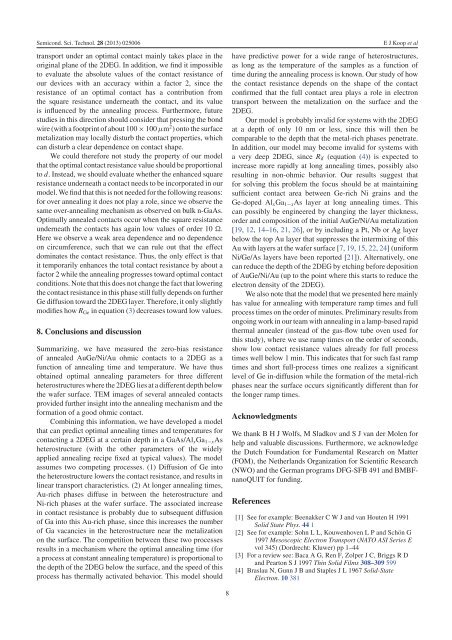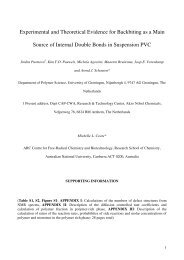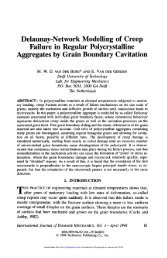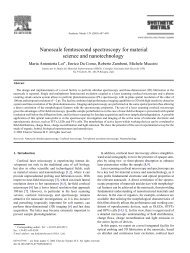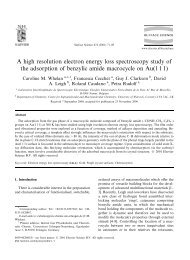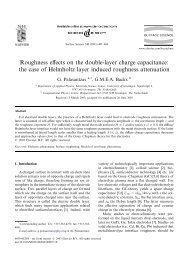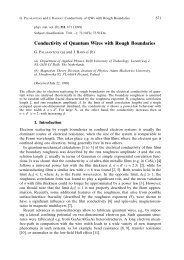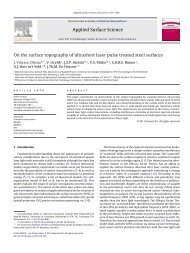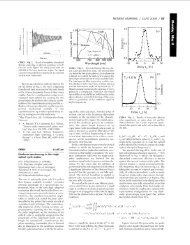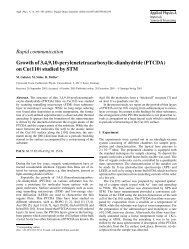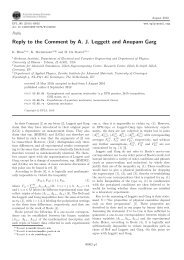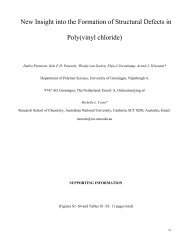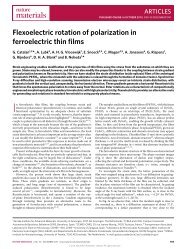On the annealing mechanism of AuGe/Ni/Au ohmic contacts to a two ...
On the annealing mechanism of AuGe/Ni/Au ohmic contacts to a two ...
On the annealing mechanism of AuGe/Ni/Au ohmic contacts to a two ...
You also want an ePaper? Increase the reach of your titles
YUMPU automatically turns print PDFs into web optimized ePapers that Google loves.
Semicond. Sci. Technol. 28 (2013) 025006transport under an optimal contact mainly takes place in <strong>the</strong>original plane <strong>of</strong> <strong>the</strong> 2DEG. In addition, we find it impossible<strong>to</strong> evaluate <strong>the</strong> absolute values <strong>of</strong> <strong>the</strong> contact resistance <strong>of</strong>our devices with an accuracy within a fac<strong>to</strong>r 2, since <strong>the</strong>resistance <strong>of</strong> an optimal contact has a contribution from<strong>the</strong> square resistance underneath <strong>the</strong> contact, and its valueis influenced by <strong>the</strong> <strong>annealing</strong> process. Fur<strong>the</strong>rmore, futurestudies in this direction should consider that pressing <strong>the</strong> bondwire (with a footprint <strong>of</strong> about 100×100µm 2 ) on<strong>to</strong> <strong>the</strong> surfacemetalization may locally disturb <strong>the</strong> contact properties, whichcan disturb a clear dependence on contact shape.We could <strong>the</strong>refore not study <strong>the</strong> property <strong>of</strong> our modelthat <strong>the</strong> optimal contact resistance value should be proportional<strong>to</strong> d. Instead, we should evaluate whe<strong>the</strong>r <strong>the</strong> enhanced squareresistance underneath a contact needs <strong>to</strong> be incorporated in ourmodel. We find that this is not needed for <strong>the</strong> following reasons:for over <strong>annealing</strong> it does not play a role, since we observe <strong>the</strong>same over-<strong>annealing</strong> <strong>mechanism</strong> as observed on bulk n-GaAs.Optimally annealed <strong>contacts</strong> occur when <strong>the</strong> square resistanceunderneath <strong>the</strong> <strong>contacts</strong> has again low values <strong>of</strong> order 10 .Here we observe a weak area dependence and no dependenceon circumference, such that we can rule out that <strong>the</strong> effectdominates <strong>the</strong> contact resistance. Thus, <strong>the</strong> only effect is thatit temporarily enhances <strong>the</strong> <strong>to</strong>tal contact resistance by about afac<strong>to</strong>r 2 while <strong>the</strong> <strong>annealing</strong> progresses <strong>to</strong>ward optimal contactconditions. Note that this does not change <strong>the</strong> fact that lowering<strong>the</strong> contact resistance in this phase still fully depends on fur<strong>the</strong>rGe diffusion <strong>to</strong>ward <strong>the</strong> 2DEG layer. Therefore, it only slightlymodifies how R Ge in equation (3) decreases <strong>to</strong>ward low values.8. Conclusions and discussionSummarizing, we have measured <strong>the</strong> zero-bias resistance<strong>of</strong> annealed <strong><strong>Au</strong>Ge</strong>/<strong>Ni</strong>/<strong>Au</strong> <strong>ohmic</strong> <strong>contacts</strong> <strong>to</strong> a 2DEG as afunction <strong>of</strong> <strong>annealing</strong> time and temperature. We have thusobtained optimal <strong>annealing</strong> parameters for three differen<strong>the</strong>terostructures where <strong>the</strong> 2DEG lies at a different depth below<strong>the</strong> wafer surface. TEM images <strong>of</strong> several annealed <strong>contacts</strong>provided fur<strong>the</strong>r insight in<strong>to</strong> <strong>the</strong> <strong>annealing</strong> <strong>mechanism</strong> and <strong>the</strong>formation <strong>of</strong> a good <strong>ohmic</strong> contact.Combining this information, we have developed a modelthat can predict optimal <strong>annealing</strong> times and temperatures forcontacting a 2DEG at a certain depth in a GaAs/Al x Ga 1−x Asheterostructure (with <strong>the</strong> o<strong>the</strong>r parameters <strong>of</strong> <strong>the</strong> widelyapplied <strong>annealing</strong> recipe fixed at typical values). The modelassumes <strong>two</strong> competing processes. (1) Diffusion <strong>of</strong> Ge in<strong>to</strong><strong>the</strong> heterostructure lowers <strong>the</strong> contact resistance, and results inlinear transport characteristics. (2) At longer <strong>annealing</strong> times,<strong>Au</strong>-rich phases diffuse in between <strong>the</strong> heterostructure and<strong>Ni</strong>-rich phases at <strong>the</strong> wafer surface. The associated increasein contact resistance is probably due <strong>to</strong> subsequent diffusion<strong>of</strong> Ga in<strong>to</strong> this <strong>Au</strong>-rich phase, since this increases <strong>the</strong> number<strong>of</strong> Ga vacancies in <strong>the</strong> heterostructure near <strong>the</strong> metalizationon <strong>the</strong> surface. The competition between <strong>the</strong>se <strong>two</strong> processesresults in a <strong>mechanism</strong> where <strong>the</strong> optimal <strong>annealing</strong> time (fora process at constant <strong>annealing</strong> temperature) is proportional <strong>to</strong><strong>the</strong> depth <strong>of</strong> <strong>the</strong> 2DEG below <strong>the</strong> surface, and <strong>the</strong> speed <strong>of</strong> thisprocess has <strong>the</strong>rmally activated behavior. This model shouldE J Koop et alhave predictive power for a wide range <strong>of</strong> heterostructures,as long as <strong>the</strong> temperature <strong>of</strong> <strong>the</strong> samples as a function <strong>of</strong>time during <strong>the</strong> <strong>annealing</strong> process is known. Our study <strong>of</strong> how<strong>the</strong> contact resistance depends on <strong>the</strong> shape <strong>of</strong> <strong>the</strong> contactconfirmed that <strong>the</strong> full contact area plays a role in electrontransport between <strong>the</strong> metalization on <strong>the</strong> surface and <strong>the</strong>2DEG.Our model is probably invalid for systems with <strong>the</strong> 2DEGat a depth <strong>of</strong> only 10 nm or less, since this will <strong>the</strong>n becomparable <strong>to</strong> <strong>the</strong> depth that <strong>the</strong> metal-rich phases penetrate.In addition, our model may become invalid for systems witha very deep 2DEG, since R if (equation (4)) is expected <strong>to</strong>increase more rapidly at long <strong>annealing</strong> times, possibly alsoresulting in non-<strong>ohmic</strong> behavior. Our results suggest thatfor solving this problem <strong>the</strong> focus should be at maintainingsufficient contact area between Ge-rich <strong>Ni</strong> grains and <strong>the</strong>Ge-doped Al x Ga 1−x As layer at long <strong>annealing</strong> times. Thiscan possibly be engineered by changing <strong>the</strong> layer thickness,order and composition <strong>of</strong> <strong>the</strong> initial <strong><strong>Au</strong>Ge</strong>/<strong>Ni</strong>/<strong>Au</strong> metalization[19, 12, 14–16, 21, 26], or by including a Pt, Nb or Ag layerbelow <strong>the</strong> <strong>to</strong>p <strong>Au</strong> layer that suppresses <strong>the</strong> intermixing <strong>of</strong> this<strong>Au</strong> with layers at <strong>the</strong> wafer surface [7, 19, 15, 22, 24] (uniform<strong>Ni</strong>/Ge/As layers have been reported [21]). Alternatively, onecan reduce <strong>the</strong> depth <strong>of</strong> <strong>the</strong> 2DEG by etching before deposition<strong>of</strong> <strong><strong>Au</strong>Ge</strong>/<strong>Ni</strong>/<strong>Au</strong> (up <strong>to</strong> <strong>the</strong> point where this starts <strong>to</strong> reduce <strong>the</strong>electron density <strong>of</strong> <strong>the</strong> 2DEG).We also note that <strong>the</strong> model that we presented here mainlyhas value for <strong>annealing</strong> with temperature ramp times and fullprocess times on <strong>the</strong> order <strong>of</strong> minutes. Preliminary results fromongoing work in our team with <strong>annealing</strong> in a lamp-based rapid<strong>the</strong>rmal annealer (instead <strong>of</strong> <strong>the</strong> gas-flow tube oven used forthis study), where we use ramp times on <strong>the</strong> order <strong>of</strong> seconds,show low contact resistance values already for full processtimes well below 1 min. This indicates that for such fast ramptimes and short full-process times one realizes a significantlevel <strong>of</strong> Ge in-diffusion while <strong>the</strong> formation <strong>of</strong> <strong>the</strong> metal-richphases near <strong>the</strong> surface occurs significantly different than for<strong>the</strong> longer ramp times.AcknowledgmentsWe thank B H J Wolfs, M Sladkov and S J van der Molen forhelp and valuable discussions. Fur<strong>the</strong>rmore, we acknowledge<strong>the</strong> Dutch Foundation for Fundamental Research on Matter(FOM), <strong>the</strong> Ne<strong>the</strong>rlands Organization for Scientific Research(NWO) and <strong>the</strong> German programs DFG-SFB 491 and BMBFnanoQUITfor funding.References[1] See for example: Beenakker C W J and van Houten H 1991Solid State Phys. 44 1[2] See for example: Sohn L L, Kouwenhoven L P and Schön G1997 Mesoscopic Electron Transport (NATO ASI Series Evol 345) (Dordrecht: Kluwer) pp 1–44[3] For a review see: Baca A G, Ren F, Zolper J C, Briggs R Dand Pear<strong>to</strong>n S J 1997 Thin Solid Films 308–309 599[4] Braslau N, Gunn J B and Staples J L 1967 Solid-StateElectron. 10 3818


